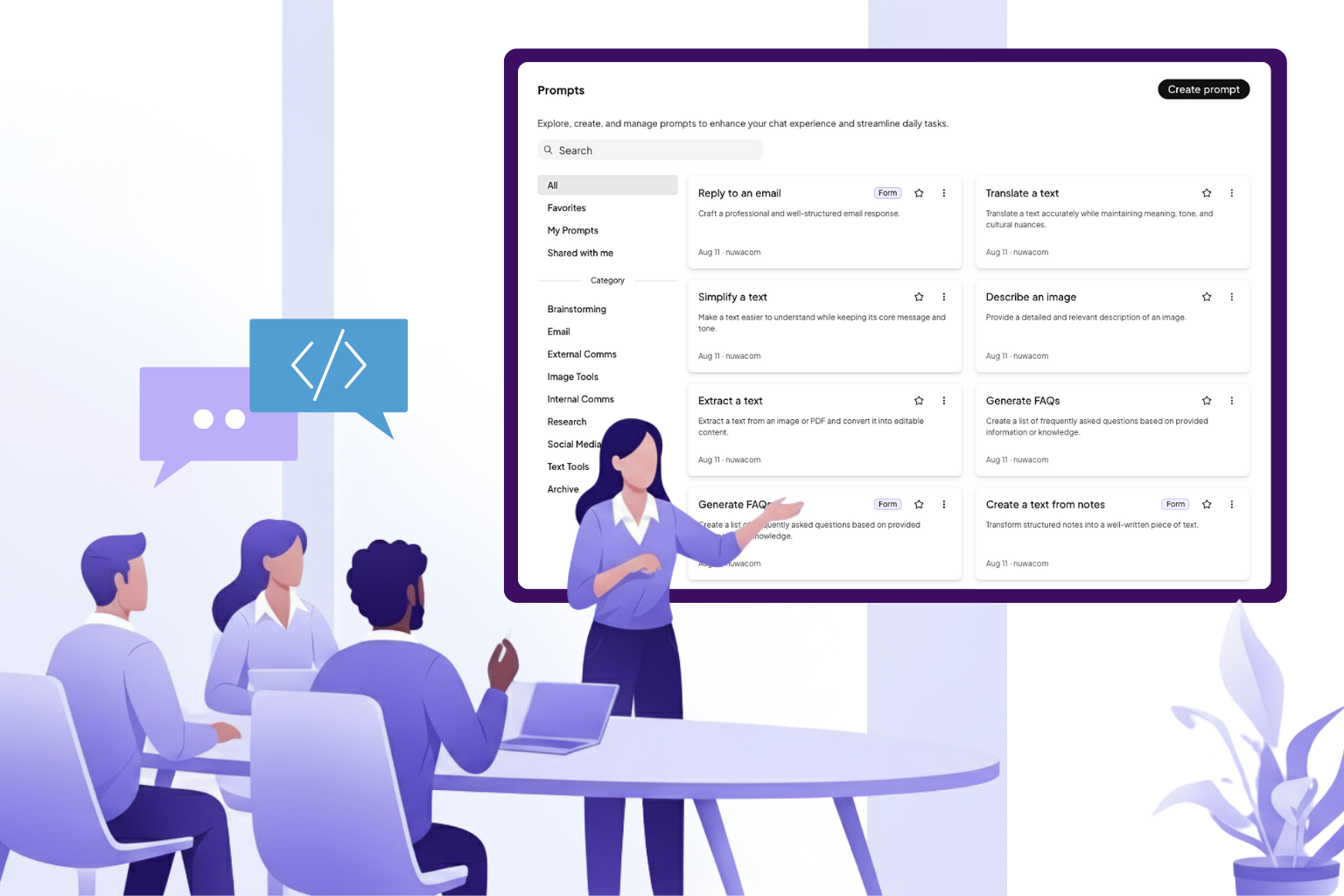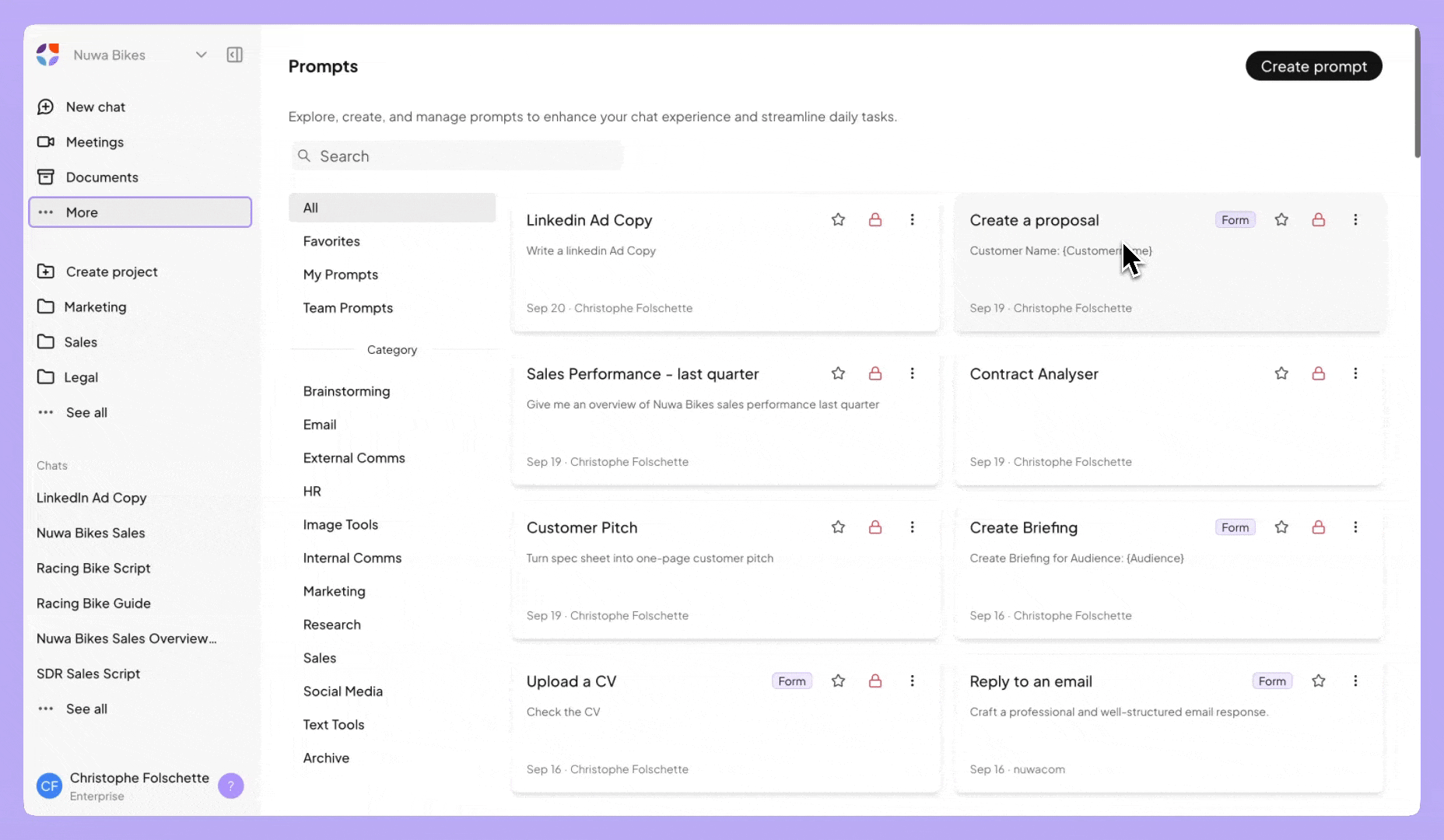Prompt Engineering in Practice – Examples & Best Practices for Businesses

What is Prompt Engineering?
A prompt is more than just a question. It can include:
- 🧑⚖️ Role Description: “You are an experienced lawyer …”
- 📚 Context Information: “Here are our internal guidelines …”
- 📝 Task: “Summarize the key points in a list.”
- 📊 Format Specification: “Provide the result in a table with three columns.”
In practice, different methods are distinguished:
- Zero-Shot Prompting: Instructions without examples.
- Few-Shot Prompting: Including examples in the prompt.
- Chain-of-Thought Prompting: Asking for explanations of intermediate steps.
- Prompt Design: Deliberate structuring to optimize output.
➡️ For businesses, this means: Prompt Engineering is not a “nice-to-have” but the foundation for using AI reliably, efficiently, and securely.
Core Principles of Successful Prompt Engineering
1. Clarity & Precision
Unclear questions lead to unclear answers. A prompt should clearly state what is expected.
👉 Example:
❌ “Write something about data protection.”
✔️ “Summarize the three key requirements of GDPR for data processors in a maximum of five bullet points.”
2. Utilizing Roles & Personas
Assigning a role to the AI helps steer responses.
👉 Example:
“You are an experienced IT security consultant. Create an understandable overview of the top cybersecurity risks for 2025 for the executive team.”
3. Providing Context
Models perform better when they know the relevant background.
👉 Example:
“Here are excerpts from our IT security concept. Please summarize the measures and compare them with the requirements of ISO 27001.”
4. Defining Structure & Format
The clearer the desired output format, the more usable the result.
👉 Examples:
“Create a table with the columns Risk, Probability, Impact.”
“Write a management summary in max. 150 words.”
5. Iteration & Feedback Loops
Prompt Engineering is a process. Results should be reviewed, improved, and iterated. Businesses benefit when prompts are documented and standardized – creating company-wide prompt knowledge.
Examples from Business Practice
1. Marketing & Communication
- Prompt: “You are an experienced editor. Create five LinkedIn post ideas for our sustainability project. Each idea should include a headline, a core message, and a CTA.”
- Benefit: Faster campaign ideas, consistent messaging, less time spent on content creation.
2. HR & Recruiting
- Prompt: “Draft a job posting for the position of ‘Data Scientist.’ Target audience: entry-level professionals. Use clear language, highlight development opportunities, and list three key tasks.”
- Benefit: More attractive job postings, time savings, better candidate experience.
3. Compliance & Legal
- Prompt: “Analyze this contract document (see below) and highlight potential risks regarding data protection and liability. Provide the results in a table with columns ‘Risk,’ ‘Location in Document,’ and ‘Comment.’”
- Benefit: Faster risk analyses, support for legal teams, consistent documentation.
4. IT & Development
- Prompt: “You are a senior developer. Review the following code snippet for security vulnerabilities and suggest improvements. Document the changes step by step.”
- Benefit: Support for development teams, quality improvement, fewer bugs.
5. Knowledge Management & Onboarding
- Prompt: “Summarize the key content from this handbook for new employees. Create an FAQ with ten typical questions and short answers.”
- Benefit: More efficient onboarding, better knowledge transfer, fewer follow-up questions.
🌟 Best Practices for Businesses
Prompt Engineering unfolds its full potential when businesses implement it in a structured and scalable way. A few good prompts are not enough – a systematic approach is crucial.
1. Build Prompt Libraries
Instead of having each employee create their own prompts, it’s worth building a central collection of verified prompts. These can be sorted by department (Marketing, HR, IT, Compliance) and continuously expanded.
2. Standardization & Governance
- Defined formats (e.g., always with sources, always with output structure) ensure quality.
- Governance ensures that AI outputs comply with company policies.
- Especially important in regulated industries: auditability of prompts & results.
3. Collaborative Prompt Design
4. Training & Upskilling
5. Automation with Agents & Workflows
Advanced companies use Prompt Engineering not only manually but also automatically:
- Agents that generate and adapt prompts themselves.
- Workflows that execute multiple prompts in sequence (e.g., research → analysis → report).

Common Mistakes & How to Avoid Them
Mistake 1: Prompts Too Vague
❌ “Explain something about AI.”
✔️ Better: “Explain the benefits of RAG Enterprise Search for compliance in banking in max. 200 words.”
Mistake 2: Missing Context
❌ “Write a press release.”
✔️ Better: “Write a press release about our new partnership with Company X. Target audience: trade journalists. Style: factual-professional. Length: approx. 400 words.”
Mistake 3: No Format Specified
❌ “List the risks.”
✔️ Better: “Create a table with the columns Risk, Probability, Impact, Mitigation.”
Mistake 4: Copy-Paste Prompts Without Iteration
Mistake 5: Dependency on a Single Model
Future: From Prompt Engineering to Prompt Orchestration
1. AI Agents Generate Prompts Themselves
2. Multi-Step Workflows
Complex tasks will be broken down into multiple steps:
- Research → Analysis → Synthesis → Output
- Each step uses its own prompts that build on each other.
- Result: transparent, structured processes instead of black-box answers.
3. Built-in Governance & Compliance
Orchestrated prompts operate within defined policies:
- Only approved data sources
- Role and rights concepts
- Auditable outputs with source references
4. Vision: Prompts as Corporate Knowledge
Conclusion
✔️ Practical Examples: From marketing to HR to compliance
✔️ Best Practices: Libraries, standardization, collaboration, training
✔️ Avoiding Mistakes: Clarity, format, iteration, model agnosticism
✔️ Future: From Prompt Engineering to orchestrated, agent-based AI
Companies that want to systematically introduce Prompt Engineering rather than just experiment should act now:
FAQ
What is Prompt Engineering?
Prompt Engineering refers to the art of guiding Large Language Models (LLMs) through precise instructions, roles, context, and structure to deliver desired and usable results.
What is the difference between Prompt Engineering and Prompt Design?
- Prompt Engineering: Systematic approach, including iteration, testing, and feedback loops.
- Prompt Design: Concrete design of individual prompts (form, structure, format).
Why is Prompt Engineering important for companies?
What application examples are there?
- Marketing: Content ideas & campaigns
- HR: Job ads & onboarding
- Compliance: Risk analyses & audits
- IT: Code generation & bug fixing
- Knowledge Management: FAQ creation & document synthesis
What best practices should companies follow?
- Build central prompt libraries
- Introduce governance & standardization
- Promote collaborative prompt design
- Specifically train employees
- Integrate prompts into workflows & agents
What mistakes should be avoided?
- Too vague formulations
- Missing context
- No format specifications
- Copy-paste without iteration
- Dependency on only one model
How will Prompt Engineering develop in the future?
Companies are moving from simple Prompt Engineering to Prompt Orchestration: AI agents generate prompts themselves, control multi-step workflows, and work embedded in governance frameworks.
Follow us on LinkedIn